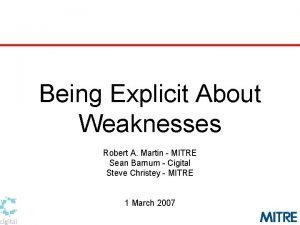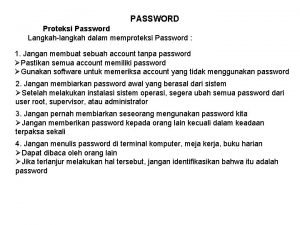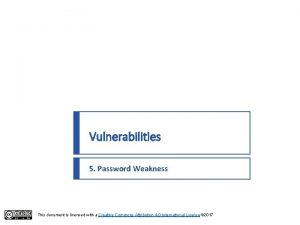Password Weakness What makes a password weak Password













- Slides: 13

Password Weakness

What makes a password “weak” ? ? • Password strength is usually determined by predictability • A password that is easy to predict is easy to crack • Including a mix of: • Lower case letters • Upper case letters • Numbers • Symbols • All of this contributes to making a password more secure

Hashing vs Encryption • Encryption is a two-way function; encrypted messages can be decrypted using the proper key • Hashing is a one-way function that scrambles text to produce a unique message. With a properly written algorithm, there is no way to reverse the hashing process

Password Storage • Passwords used to be stored in the clear on UNIX systems; in order to get passwords you just had to know where they were stored • In the next attempt to increase security, passwords were hashed using wellknown hashing algorithms ( such as MD 5) and then stored • To check if a correct password had been supplied, the supplied password would be hashed using the same algorithm and compared to the original hashed value. If the values were the same, the passwords must have matched.

An example of an easily-cracked hash (CRC) This is the output:

The Next Step: • While most hashes used were not as simple as the CRC hash, hackers were still able to break the passwords by creating “rainbow tables” • Rainbow tables were a database of passwords and their hash values for a given algorithm • If the table of hashed passwords was available (most of the time it was), the cracker just had to look up the hashed value in the rainbow table to reveal the original password.

The Next Step: • In order to fix this problem, “salt” was created. Salt is a value (unique to the machine being used) that is combined with the password to create new hash values for passwords • This made the rainbow tables virtually useless Example of a rainbow table

More Problems: • However, hackers are very aware of how people come up with their passwords. • Users are in the habit of choosing standard dictionary words, names, and dates. They also know that if there are complexity requirements, the uppercase is likely to be at the beginning of the dictionary word and a number at the end • Password crackers study lists of released passwords and try the most popular ones first • Of course, this can easily be avoided with a secure, unique password • There are multiple lists of leaked passwords on this page: https: //wiki. skullsecurity. org/Passwords

In This Lab: • You will see how the “guess and check” method works using the leaked lists that are found online and some simple python code. • You will run simple md 5 hashes through a program that will check to see if the hash matches any of the passwords in a specified list of passwords • This is how it works:

• This code takes each of the words in the list and hashes them using the md 5 hash. • It then checks the new hash with the hash that you previously provided for the “hash” variable.


Here is the code you should use to begin (remember you can modify it)

 Weak acid strong base titration
Weak acid strong base titration Weak acid and weak base reaction
Weak acid and weak base reaction Strong base
Strong base Choleric weaknesses
Choleric weaknesses A company weakness or competitive deficiency
A company weakness or competitive deficiency Phenomenology strengths and weaknesses
Phenomenology strengths and weaknesses What is the weakness of qualitative research
What is the weakness of qualitative research Swot analysis of tata nano
Swot analysis of tata nano Mitre cwe
Mitre cwe Intel vs amd advantages and disadvantages
Intel vs amd advantages and disadvantages Strength and weakness of family business
Strength and weakness of family business Nursing peer review strengths and weaknesses examples
Nursing peer review strengths and weaknesses examples Weakness in isolation privilege
Weakness in isolation privilege Overt observation
Overt observation
























